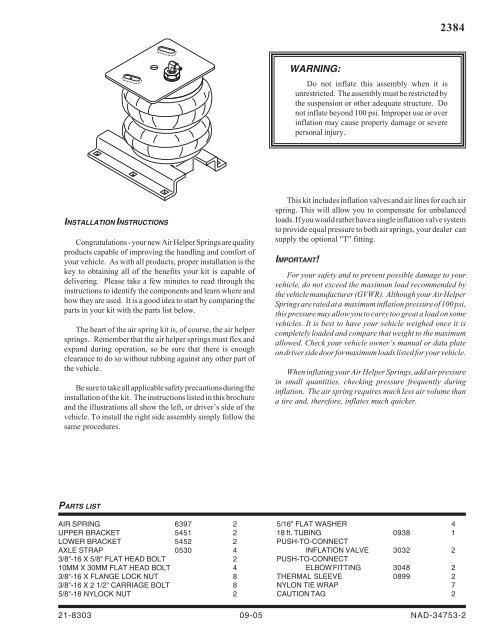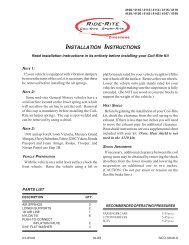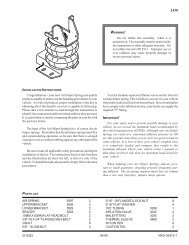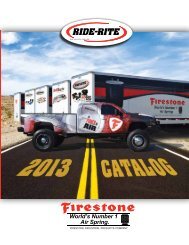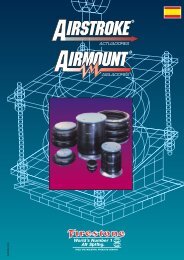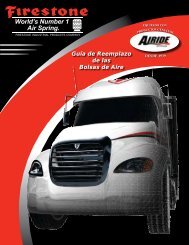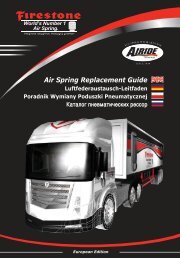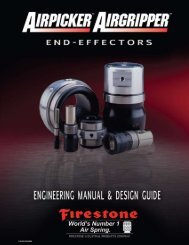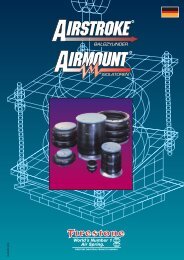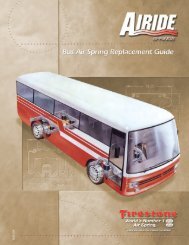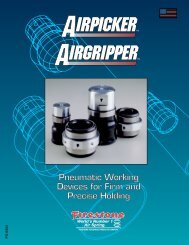Installation Instruction - Firestone
Installation Instruction - Firestone
Installation Instruction - Firestone
You also want an ePaper? Increase the reach of your titles
YUMPU automatically turns print PDFs into web optimized ePapers that Google loves.
PARTS LIST<br />
TIRE<br />
INSTALLATION INSTRUCTIONS<br />
Congratulations - your new Air Helper Springs are quality<br />
products capable of improving the handling and comfort of<br />
your vehicle. As with all products, proper installation is the<br />
key to obtaining all of the benefits your kit is capable of<br />
delivering. Please take a few minutes to read through the<br />
instructions to identify the components and learn where and<br />
how they are used. It is a good idea to start by comparing the<br />
parts in your kit with the parts list below.<br />
The heart of the air spring kit is, of course, the air helper<br />
springs. Remember that the air helper springs must flex and<br />
expand during operation, so be sure that there is enough<br />
clearance to do so without rubbing against any other part of<br />
the vehicle.<br />
Be sure to take all applicable safety precautions during the<br />
installation of the kit. The instructions listed in this brochure<br />
and the illustrations all show the left, or driver’s side of the<br />
vehicle. To install the right side assembly simply follow the<br />
same procedures.<br />
AIR SPRING 6397 2<br />
UPPER BRACKET 5451 2<br />
LOWER BRACKET 5452 2<br />
AXLE STRAP 0530 4<br />
3/8"-16 X 5/8" FLAT HEAD BOLT 2<br />
10MM X 30MM FLAT HEAD BOLT 4<br />
3/8"-16 X FLANGE LOCK NUT 8<br />
3/8"-16 X 2 1/2" CARRIAGE BOLT 8<br />
5/8"-18 NYLOCK NUT 2<br />
WARNING:<br />
Do not inflate this assembly when it is<br />
unrestricted. The assembly must be restricted by<br />
the suspension or other adequate structure. Do<br />
not inflate beyond 100 psi. Improper use or over<br />
inflation may cause property damage or severe<br />
personal injury.<br />
2384<br />
This kit includes inflation valves and air lines for each air<br />
spring. This will allow you to compensate for unbalanced<br />
loads. If you would rather have a single inflation valve system<br />
to provide equal pressure to both air springs, your dealer can<br />
supply the optional "T" fitting.<br />
IMPORTANT!<br />
For your safety and to prevent possible damage to your<br />
vehicle, do not exceed the maximum load recommended by<br />
the vehicle manufacturer (GVWR). Although your Air Helper<br />
Springs are rated at a maximum inflation pressure of 100 psi,<br />
this pressure may allow you to carry too great a load on some<br />
vehicles. It is best to have your vehicle weighed once it is<br />
completely loaded and compare that weight to the maximum<br />
allowed. Check your vehicle owner’s manual or data plate<br />
on driver side door for maximum loads listed for your vehicle.<br />
When inflating your Air Helper Springs, add air pressure<br />
in small quantities, checking pressure frequently during<br />
inflation. The air spring requires much less air volume than<br />
a tire and, therefore, inflates much quicker.<br />
5/16" FLAT WASHER 4<br />
18 ft. TUBING 0938 1<br />
PUSH-TO-CONNECT<br />
INFLATION VALVE 3032 2<br />
PUSH-TO-CONNECT<br />
ELBOW FITTING 3048 2<br />
THERMAL SLEEVE 0899 2<br />
NYLON TIE WRAP 7<br />
CAUTION TAG 2<br />
21-8303 09-05 NAD-34753-2
FRAME<br />
UPPER<br />
BRACKET<br />
10MM X 30MM<br />
FLAT HEAD<br />
BOLT<br />
KIT ASSEMBLY<br />
AIR<br />
SPRING<br />
UPPER<br />
BRACKET<br />
LOWER<br />
BRACKET<br />
UPPER BRACKET INSTALLATION<br />
HOLES FROM<br />
JOUNCE BUMPER<br />
REMOVAL<br />
AIR<br />
SPRING<br />
4X4 AND Z71 2WD<br />
ELBOW<br />
FITTING<br />
5/8”-18<br />
HEX NUT<br />
5/8” LOCK<br />
WASHER<br />
3/8”-16 X 5/8”<br />
FLAT HEAD<br />
BOLT<br />
FRAME<br />
UPPER<br />
BRACKET<br />
10MM X 30MM<br />
FLAT HEAD<br />
BOLT<br />
3/8”-16 X 2 1/2”<br />
CARRIAGE BOLT<br />
LEAF STACK<br />
WHEEL<br />
HOLES FROM<br />
JOUNCE BUMPER<br />
REMOVAL<br />
JOUNCE<br />
BUMPER<br />
SUPPORT<br />
2WD, NON-Z71<br />
FRONT<br />
FIGURE “A”<br />
JOUNCE<br />
STOP<br />
AXLE<br />
AIR<br />
SPRING<br />
NOTE: UPPER & LOWER<br />
BRACKET INSTALLATION<br />
DIFFERS BETWEEN<br />
2WD AND 4X4 & Z71.<br />
PLEASE SEE INSTRUCTIONS.<br />
AXLE<br />
STRAP<br />
AIR<br />
SPRING<br />
ASSEMBLY<br />
TIRE<br />
LOWER BRACKET<br />
INSTALLATION<br />
3/8”-16 FLANGE<br />
LOCK NUT
FRAME RAIL<br />
AIR<br />
SPRINGS<br />
AXLE STRAP<br />
AIR LINE<br />
PUSH-TO-CONNECT<br />
INFLATION VALVE<br />
DRIVER'S SIDE<br />
Figure "C"<br />
Figure "D"<br />
UPPER<br />
BRACKET<br />
AIR SPRING<br />
LOWER BRACKET<br />
BRAKE<br />
LINE<br />
FROM REAR, LOOKING TO FRONT<br />
4X4 & Z71/OFF ROAD<br />
BODY OF<br />
VEHICLE<br />
BUMPER<br />
AIR HOSE<br />
FLAT WASHER<br />
HEX NUT<br />
VALVE CAP<br />
Figure "B"<br />
INFLATION<br />
VALVES<br />
FRAME RAIL<br />
DRIVER'S SIDE<br />
NOTE:<br />
Please read thorough<br />
this manual completely<br />
before installing the air<br />
spring kit to your vehicle.<br />
All illustrations reference<br />
the driver’s or left side of<br />
the vehicle. Reverse all<br />
orientations for the<br />
passenger’s or right side.<br />
STEP 1 - PREPARE<br />
FROM REAR, LOOKING TO FRONT<br />
THE VEHICLE<br />
2WD, NON-Z71<br />
Remove the jounce<br />
bumper located under the<br />
frame rail or on the jounce bumper support. The jounce bumpers and<br />
bolts will not be reused with this kit.<br />
STEP 2 - PRE-ASSEMBLE THE KIT<br />
Select one air helper spring from your kit. Attach the lower<br />
bracket to the air spring using the 3/8"-16 x 5/8 flat head bolt. See<br />
Figure "A". Attach the upper bracket to the air spring with a 5/8"<br />
nylock nut. See Figure "A". The combination stud will use the<br />
larger diameter hole and the alignment "button" will use the smaller<br />
diameter hole. Install the elbow fitting into the air spring. Tighten the<br />
air fitting securely to engage the orange thread sealant. Position the<br />
fitting to point to the anticipated location of the air inflation valves,<br />
see Figure "A" & "C".<br />
STEP 3 - INSTALLING THE ASSEMBLY TO THE VEHICLE<br />
Place the assembly on the jounce stop of the driver’s side, see<br />
Figures "A" & "B".Using the existing jounce bumper holes, install<br />
the upper bracket onto the frame with 10MM x 30MM flat head<br />
bolts, see Figure "A". Attach the lower bracket to the axle using<br />
the axle strap or straps, 3/8"-16 x 2 1/2" carriage bolts, and 3/8"-16<br />
flange lock nuts, see Figure “A” & "B". Once the assembly is in<br />
place, you must have a minimum of 1/2" clearance around<br />
the air spring.<br />
STEP 4 - PASSENGER'S SIDE INSTALLATION<br />
Follow steps 1-3 with reverse orientations for assembly and installation of the passenger’s side.<br />
STEP 5 - INSTALL THE AIR LINE AND INFLATION VALVE<br />
Uncoil the airline tubing and cut it into two equal lengths. DO NOT FOLD OR KINK THE AIRLINE TUBING.<br />
Try to make the cut as square as possible. Insert one end of the airline tubing into the air fitting installed in the<br />
top of the air helper spring. Push the airline tubing into the fitting as far as possible see Figure “A”. Select a<br />
location on the vehicle for the air inflation valves. The location can be on the bumper or the body of the vehicle,<br />
as long as it is in a protected location so the valve will not be damaged, but maintain accessibility for the air<br />
chuck, see Figure “C”. Drill a 5/16" hole and install the air inflation valve using two 5/16" flat washers per<br />
valve as supports, see Figure “D”.<br />
Run the airline tubing from the air helper spring to the valve, routing it to avoid direct heat from the engine,<br />
exhaust pipe, and away from sharp edges. Thermal sleeves have been provided for these conditions.<br />
BRAKE<br />
LINE<br />
JOUNCE<br />
BUMPER<br />
SUPPORT<br />
AXLE STRAP<br />
UPPER<br />
BRACKET<br />
AIR SPRING<br />
LOWER BRACKET
The airline tubing should not be bent or curved sharply as it may buckle. Secure the airline tubing in place with<br />
the nylon ties provided. Push the end of the airline tubing into the inflation valve as illustrated see Figure “D”.<br />
STEP 6 - CHECK THE AIR SYSTEM<br />
Once the inflation valves are installed, inflate the air helper springs to 70 psi and check the fittings for air leaks.<br />
Using a spray bottle, apply a solution of soap and water to the fittings. If a leak is detected at an airline tubing<br />
connection then check to make sure that the airline tube is cut as square as possible and that it is pushed completely<br />
into the fitting. The airline tubing can easily be removed from the fittings by exhausting all the pressure in<br />
the air springs and then pushing the collar towards the body of the fitting and then, with a gentle pull, remove the<br />
airline tubing. If a leak is detected where the air<br />
fitting screws into the spring, deflate the air springs and remove the tubing, then screw the air fitting into the air<br />
spring one additional turn or until the leak stops. Reinstall the tubing and re-inflate the air springs and check for<br />
leaks as noted above. This now completes the installation. With a load on your vehicle and the air helper springs<br />
inflated, you must have at least 1/2" clearance around the air springs. As a general rule, the air helper springs will<br />
support approximately 50 lbs. of load for each 1 psi of inflation pressure (per pair). For example, 50 psi of<br />
inflation pressure will support a load of 2500 lbs. per pair of air helper springs. FOR BEST RIDE use only<br />
enough air pressure in the air helper springs to level the vehicle when viewed from the side (front to rear). This<br />
amount will vary depending on the load, location of load, condition of existing suspension and personal preference.<br />
NOTE: Too much air pressure in the air helper springs will result in a firmer ride, while too little air pressure will<br />
allow the air helper spring to bottom out over rough conditions. Too little air pressure will not provide the<br />
improvement in handling that is possible. TO PREVENT POSSIBLE DAMAGE MAINTAIN A MINI-<br />
MUM OF 5 psi IN THE AIR HELPER SPRINGS AT ALL TIMES.<br />
NOTE:<br />
MIN PRESSURE 5 PSI<br />
MAX PRESSURE (LOADED) 100 PSI<br />
NOTE:<br />
This kit was designed to work on vehicles with their original suspension. With the vehicle on the ground,<br />
unloaded, and 0 PSI in the air springs, the ride height of the air springs will be 5" to 6.5" tall.<br />
Should it become necessary to raise the vehicle by the frame, deflate both air helper springs completely.<br />
Reinflate the air springs after the vehicle is lowered to the ground.


